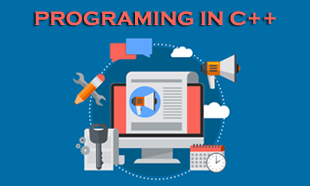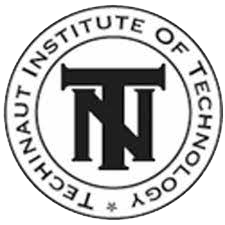0
TECHINAUT INSTITUTE OF TECHNOLOGY PRABHA INSTITUTE OF TECHNOLOGY ABOUT THE “PROGRAMMING COURSE IN C++” SYLLABUS This is a revised …
TECHINAUT INSTITUTE OF TECHNOLOGY
PRABHA INSTITUTE OF TECHNOLOGY
ABOUT THE “PROGRAMMING COURSE IN C++” SYLLABUS
This is a revised and updated version of TECHINAUT INSTITUTE OF TECHNOLOGY syllabus of PROGRAMMING COURSE IN C++. This PROGRAMMING COURSE IN C++ course is for beginner programmer how are looking carriers in computer programing. Student from different courses can also go for this course.
THE OBJECTIVE OF THE COURSE
a. By the end of this course, you will be able to: b. Read and write C++ code c. Use C++ interfaces and libraries d. Understand how to use object-oriented design principles in the context of the C++ language e. Understand key concepts such as abstract interfaces, polymorphism, and data abstraction.
LEARNING OUTCOMES a. At the conclusion of this course, you should be able to: b. Understand object-oriented programming features in C++, c. Apply these features to program design and implementation, d. Understand object-oriented concepts and how they are supported by C++ e. Gain some practical experience of C++ f. Understand implementation issues related to object-oriented techniques, g. Build good quality software using object-oriented techniques, and h. Understand the role of patterns in object-oriented design
TABLE OF CONTENT
INTRODUCTION
SECTION 1. INTRODUCTION TO C++ (2 HRS)
What is object-oriented programming? Why do we need object-oriented? Programming characteristics of object-oriented languages C and C++. a. Starting with C++ b. How C++ evolved from C? c. Features of C++ d. Procedure-oriented programming e. OOP vs. procedure-oriented programming f. The basic anatomy of a C++ program g. Starting with a simple “Hello World” program h. Compiling, linking and running a C++ program
SECTION 2. OBJECT-ORIENTED PROGRAMMING CONCEPTS (5 HRS)
Making sense of core object concepts (Encapsulation, Abstraction, Polymorphism, Classes, Messages Association, Interfaces) Implementation of class in C++, C++ Objects as physical object, C++ object as data types constructor. Object as function arguments. The default copy constructor, returning object from function. Structures and classes. Classes objects and memory static class data. Const and classes.
a. Abstraction b. Inheritance c. Polymorphism d. Data Binding e. Encapsulation f. Classes, subclasses and ObjectsSECTION 3. THE BASICS OF C++ (15 HRS)
Output using cout. Directives. Input with cin. Type bool. The setw manipulator. Type conversions. a. Base Data Types and sizes b. User-defined Data Types c. Variable Declarations, Variable Names d. Dynamic initialization of variables e. Constants and its types 1. Character Constants 2. String Constants f. Standard input and standard output 1. Formatted input –cin 2. Formatted output – cout 3. Use of << and >> operators
START WORKING WITH C++
SECTION 4. WORKING WITH OPERATORS AND EXPRESSIONS (10 HRS)
a. Operators b. Arithmetic Operators c. Relational Operators d. Assignment Operator e. Logical Operators f. Increment and Decrement Operators (++ and --) g. 'Operate-Assign' Operators (+=, *=, ...) h. Expressions 1. What are Expressions? 2. Operator Precedence 3. Precedence and Order of Evaluation 4. Conditional Expression 5. Casting and type conversion
SECTION 5. CONTROLLING THE PROGRAM FLOW (10 HRS)
a. Decision control 1. If 2. if – else 3. if - else if b. Loop Control 1. While 2. do – while 3. for 4. break 5. continue c. Case Control 1. Switch 2. Goto
SECTION 5. USING FUNCTIONS/PROCEDURES (10 HRS)
Returning values from functions. Reference arguments. Overloaded function. Inline function. Default arguments. Returning by reference.
a. Why Functions? b. Anatomy of a Function c. Returning values from functions d. Arguments Passed by Value e. Passing Addresses of Arguments f. Concept of variable scope and scope rules g. Static and automatic variables h. Global variablesSOME COMPLEX PROGRAMMING IN C++
SECTION 6. POINTERS AND ARRAYS (5 HRS)
Addresses and pointers. The address of operator and pointer and arrays. Pointer and Faction pointer and C-types string. Memory management : New and Delete, pointers to objects, debugging pointers.
a. Pointers 1. What is a Pointer? 2. Pointer Initialization 3. Pointer Operators 4. The & Operator 5. Pointer Arithmetic 6. Functions and pointers b. Understanding Arrays 1. Arrays 2. Initializing Arrays 3. Passing Arrays to Functions c. Pointers and Arrays d. Pointer to an Array e. Array of pointers f. Strings 1. String I/O 2. cin and cout member functions 3. Standard C String functions 4. Arrays of StringsSECTION 7. BINDING DATA AND FUNCTIONS (5 HRS)
a. Concept of a class b. Defining a class c. Creating an object d. Object Scope e. Data Abstraction f. Enforcing Data Encapsulation g. ‘this’ Pointer h. Dynamic creation of objects i. Constructors and Destructors 1. The Default Constructor 2. The Destructor 3. Parameterized Constructors 4. Copy constructor j. Defining member functions 1. Methods and access modifiers k. Accessing class data and methods l. Friend class and friendly functions m. Returning objects n. Arrays of Objects
SECTION 8. FUNCTION AND OPERATOR OVERLOADING (5 HRS)
Returning values from functions. Reference arguments. Overloaded function. Inline function. Default arguments. Returning by reference. Overloading unary operations. Overloading binary operators, data conversion, pitfalls of operators overloading and conversion keywords. Explicit and Mutable.
a. Function Overloading 1. Using overloaded functions 2. Rules for overloading b. Operator overloading and its uses 1. Overloading unary and binary operators 2. Overloading the assignment operator 3. Overloading the << Operator 4. Overloading the increment and decrement operator c. Dealing with strings using operators 1. Converting data types 1. Basic to class type 2. Class to basic type 3. Class to another class typeADVANCE C++
SECTION 9. REUSING CLASSES (8 HRS)
Concept of inheritance. Derived class and based class. Derived class constructors, member function, inheritance in the English distance class, class hierarchies, inheritance and graphics shapes, public and private inheritance, aggregation: Classes within classes, inheritance and program development. a. Inheritance-Base and Derived classes b. Inheritance types c. Scope Resolution operator d. Access Modifiers e. Access and Inheritance f. Constructors and Inheritance g. Multiple & Multilevel Inheritance h. Calling base class constructor i. Overriding base class members
SECTION 10. VIRTUAL FUNCTIONS AND POLYMORPHISM (5 HRS)
Virtual Function, friend function, Static function, Assignment and copy initialization, this pointer, dynamic type information. a. Virtual & non-virtual Overriding b. Virtual functions c. Rules for virtual functions d. Pure virtual functions e. Static and Dynamic Binding f. Virtual base classes
SECTION 10. TEMPLATES, EXCEPTION HANDLING (5 HRS)
a. Templates b. Function templates c. Class templates d. Exception handling
Lectures = 45 HRS Practical/Tutorials = 45 HRS Total = 90 HRS


